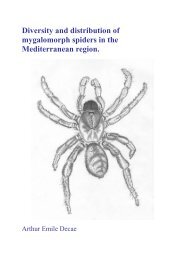PhD Reza Erfanzadeh 2009 - Ghent Ecology - Universiteit Gent
PhD Reza Erfanzadeh 2009 - Ghent Ecology - Universiteit Gent
PhD Reza Erfanzadeh 2009 - Ghent Ecology - Universiteit Gent
You also want an ePaper? Increase the reach of your titles
YUMPU automatically turns print PDFs into web optimized ePapers that Google loves.
exhibit increased species diversity, yield and amounts of organic matter with time (Odum<br />
1969). Succession processes such as “facilitation” and “inhibition” are associated with it<br />
(Connel & Slatyer 1977). Such features (autogenic plant succession) are indeed likely to<br />
predominate at higher elevations, where tidal influence is reduced. Lower elevations,<br />
however, experience frequent tidal inundation, associated with more complete litter removal<br />
and greater likelihood of inorganic sedimentation. This enhancement of the allogenic<br />
(environmental) influence leads to replacement of species by the tides, as for instance Eilers<br />
(1979) found in the lower salt-marshes. Consequently, inundation could influence not only the<br />
germination and growth of species but also the stability and dynamics of different species and<br />
communities. Previous studies have shown that the speed of vegetation succession in salt-<br />
marshes depends on drainage conditions and on sedimentation rates in relation to sea level<br />
rise (Leendertse et al. 1997; Olff et al. 1997; Schröder et al. 2002). Nevertheless, there is a<br />
lack of studies on vegetation replacement and succession related to inundation frequency. The<br />
effect of inundation frequency on vegetation succession (species turnover) will be studied in<br />
chapter 3. We hypothesize there that the rate of species succession and turnover at higher<br />
inundation frequencies is lower.<br />
1.3.3 Grazing and succession<br />
Grazing is one of the most important biotic disturbance factors, affecting the growth rate<br />
of species and the rate of replacement. In terrestrial habitats, animal grazing has been reported<br />
to be an important succession factor (Olff et al. 1999) and nature management tool for poor<br />
and low-productivity habitats (Provoost et al. 2002; Stroh et al. 2002; Hellström et al. 2003).<br />
Moderate grazing was beneficial to annual species, whereas ungrazed grassland was<br />
dominated by tall perennial grasses (Noy-Meir et al. 1989). Species richness increased with<br />
increasing grazing pressure, but decreased sharply when the grazing pressure was severe<br />
(Taddese et al. 2002). Although, grazing increased the number of rare species, it negatively<br />
11










